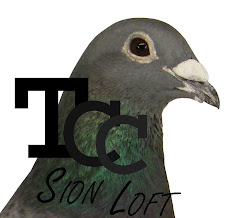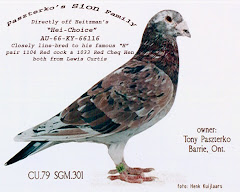ROB - E. Lowell "No Sweat" Robbins, Jr. has written several loft reports over the years but prefers to feed his hungry and unbound creative writing style by writing fiction. He is not just a story teller and current author, but has long been a successful pigeon breeder, racer, and showman. The American Racing Pigeon News featured "The Robbins Loft" way back in May 1979, after Rob won the 1978 Y.B. National Show in Louisville, KY, the 1978 National Show in White Plains, N.Y. and the 1978 Southern R. P. Assn. Show in Charleston S.C. In his 53 years as a Heitzman Sion racing pigeon specialist Rob has won over 800 firsts in racing and shows.
Enjoy this could be true fictional story...
Lascaux, France, June, 1940
You couldn't see them unless they moved.
Five camouflaged German soldiers.
A reconnaissance patrol, fragments of the Blitzkrieg.
Each soldier owning a helmet woven with grasses coming from their location near the bank of the Vezere River.
Those helmets moving as queer nests with green and brown tentacles.
Come here, whispered a cave in the woods.
Caves do talk, don't they?
This cave was not so big. A hole in the ground. An old pine had fallen exposing its entrance.
In the blue heavens the Luftwaffe and their roar of so many planes were disappearing.
Then, for a moment it was suddenly quiet.
The Germans paused, surveying the countryside; so many yellow orchids, grasshoppers and black butterflies with their scarlet trim.
Though the sun warmed their helmets and gun barrels there was a slight current of a cool breeze waxing down from the northern slopes of the Pyrenees. With it was a clean and light smell of conifers and snow. Pairs of Alpine Choughs called loudly while entering nesting caves along a cliff's face. A minute later, a small and flitting bird moved across another cliff and disappeared into a crevice. Feeding on dandelion and thistle at the woodland's edge, four Citril Finch were confiding and persistent. The melodic song of the Rock Thrush was heard and a beautiful orange and blue male was spotted singing on a rock fence.
"I'm waiting," whispered the cave.
Finally, one of the patrol found it. Soon, the others came.
Footprints. Fresh. They appeared to be that of a man's and a boy.
The footprints lead only in.
The soldiers stood astonished. There was that innocent side of them that wanted to pretend they didn't see those footprints. If they found the man and the boy they would either have to shoot them or take them to an area where they would be trucked away and probably hanged.
But the cave was such a black temptress. And the German invaders were determined to impress upon the French that it was useless to resist.
"I don't like this," spoke sergeant Isselhardt.
Just beyond those footprints having once hidden the entrance there was a rock covered in fossils. On the other side of the rock there stood a paraffin lantern. Sergeant Isselhardt still had his small signal flashlight and he buttoned it to his left front shoulder so that it hung down and aimed where he was going so that he would be able to keep his hands free. "This way," he ordered to his men.
One by one the men climbed over the rock. Then, stopping, sergeant Isselhardt turned on his flashlight. "Sit down," he lowly spoke, lighting the lantern. Then he passed the lantern down to private Yoes at the end and began leading with his flashlight. The patrol made their way in a single file, so close that they were constantly touching each other.
"How's your light?" asked corporal Heitzmann, the second soldier in the line.
"I have never been in such darkness," spoke Goldshmidt, the soldier behind him with another flashlight. "There's a feeling of death here. Let's go back."
Sergeant Isselhardt felt the same but could not show it. "My own batteries are weak and I have no more," he said, overhearing the conversation. Stay close. No talking. We'll go back when I say we go back."
"When a man in a cave has his light go out it means another man is with that man's woman," responded Yoes, grinning and carrying the lantern, causing the other soldiers to smile as well.
The first twenty meters inside the cave continued to slope steeply downward. The uncertain light of sergeant Isselhardt's signal light barely pierced the darkness.
And private Yoe's lantern cast eerie shadows.
The men's eyes finally adjusted and when they did they stood spellbound.
"Look! Unbelievable! uttered Yoes. "Can this be real? Are we in a dream?"
"Stay quiet!" ordered sergeant Isselhardt.
Above the men all along the walls in hand-painted red, yellow, brown and black colors, were a striking series of primitive wall paintings; panels of bison, reindeer and fat belly horses; the animals looked frightened; they were so vivid and real as though they themselves were seeing, breathing, hurrying, some even swimming, some having shading and three dimensional qualities.
Further along on another wall, there was another panel of paintings depicting a great black bull hiding two cows. At the back of the panel there was a horse that seemed to be dashing towards the inmost depths of the gallery. On another wall, the focal point of the composition, there was a herd of small horses and a large black cow whose distinguishing feature was an unusual movement evocative of a fall.
Man the hunter.
A dream of no end.
Cave silence.
Nothing owns the quiet of a cave.
Except a grave.
"Coo."
"Coo."
The sound of a "coo" deep inside a cave?
A soft coo.
A lonely coo.
A coo of despair.
Somehow, each man knew that coo.
Only one bird in the world could make that exact sound, a pigeon.
But a pigeon does not dwell so deep in a cave, does it?
"Coo."
Once more the cave made that mourning sound.
And every few seconds again the silence was broken.
The soldiers walked toward the sound coming into another room. On the floor was the skull of an ibex covered in calcite. Beside it were two pack frames; Each frame held a wicker crate owning four small doors. In a small space at the top of each door was the head of a pigeon. At the top of each crate was a brass nameplate: PAUL SION --- TOURCOING, FRANCE.
Not just any pigeons.
One glance into their brilliant, dark eyes told they were no accident.
They were beyond nature's touch, the art of one man.
The birds held calm, a careful intelligence at play; they were the shimmering, elite representatives of the fastest flying birds in the world, a blend of peace and wonder, beautiful homing pigeons bred to race; Something about them was almost human, as though they could speak.
Sergeant Isselhardt knew about racing pigeons, having been in many races. Oddly enough, so had corporal Heitzmann and private Yoes. Even though they had been away from their birds for some time the pigeons had remained in their dreams and they were always with them. In those dreams they would stand there in their lofts finding peace. They hated waking from those dreams as those dreams were almost perfect. They hated "the other awake world" they now dwelled in. And they hated what they knew were their given orders if they found any homing pigeons: KILL ALL HOMING PIGEONS ON THE SPOT NO QUESTIONS ASKED! Even though they were Germans they knew of France's National Champion in racing pigeons, the world famous Paul Sion. No person could begin to match Sion's magic with pigeons. And to kill these magnificent racers, well, caused the soldiers a moment to pause.
"Rat-a-tat-tat-tat, rat-a-tat-tat-tat, rat-a-tat-tat-tat, rat-a-tat-tat-tat!" opened up two machine guns hidden in the black somewhere recessed in a cleft.
All five Germans in the patrol fell dead.
Paul Sion and his son, Robert, climbed down, keeping their machine guns trained on the lifeless German soldiers. The eagle symbols on those German uniforms paled in strength for the love that Paul Sion owned for their pigeons."Get a couple of their guns," ordered Paul. "We've gotta get out of here -- quick!".
Story by: E. Lowell "No Sweat" Robbins, Jr.









